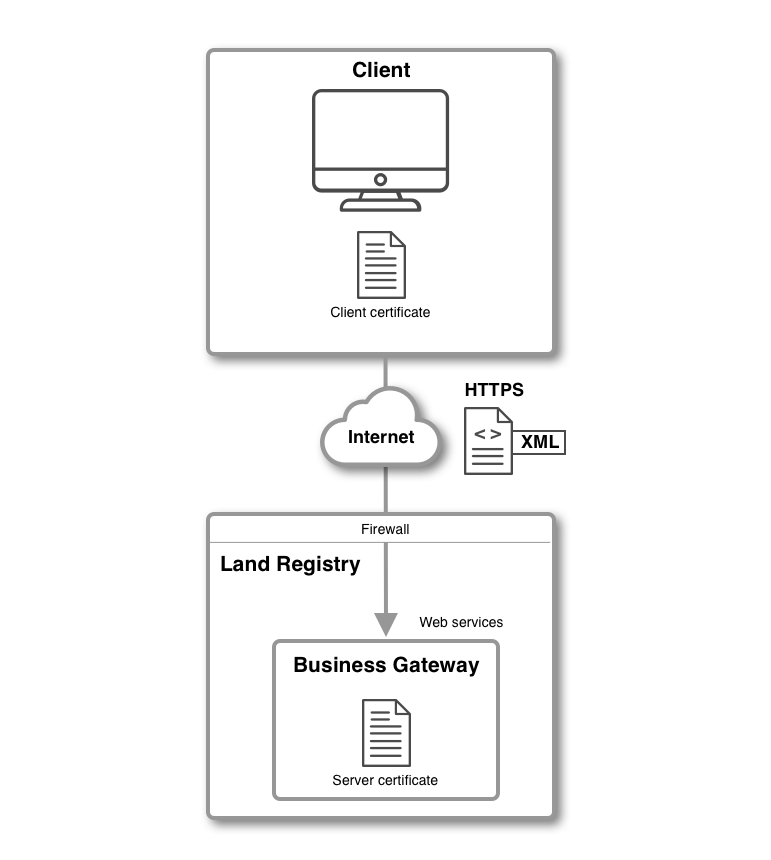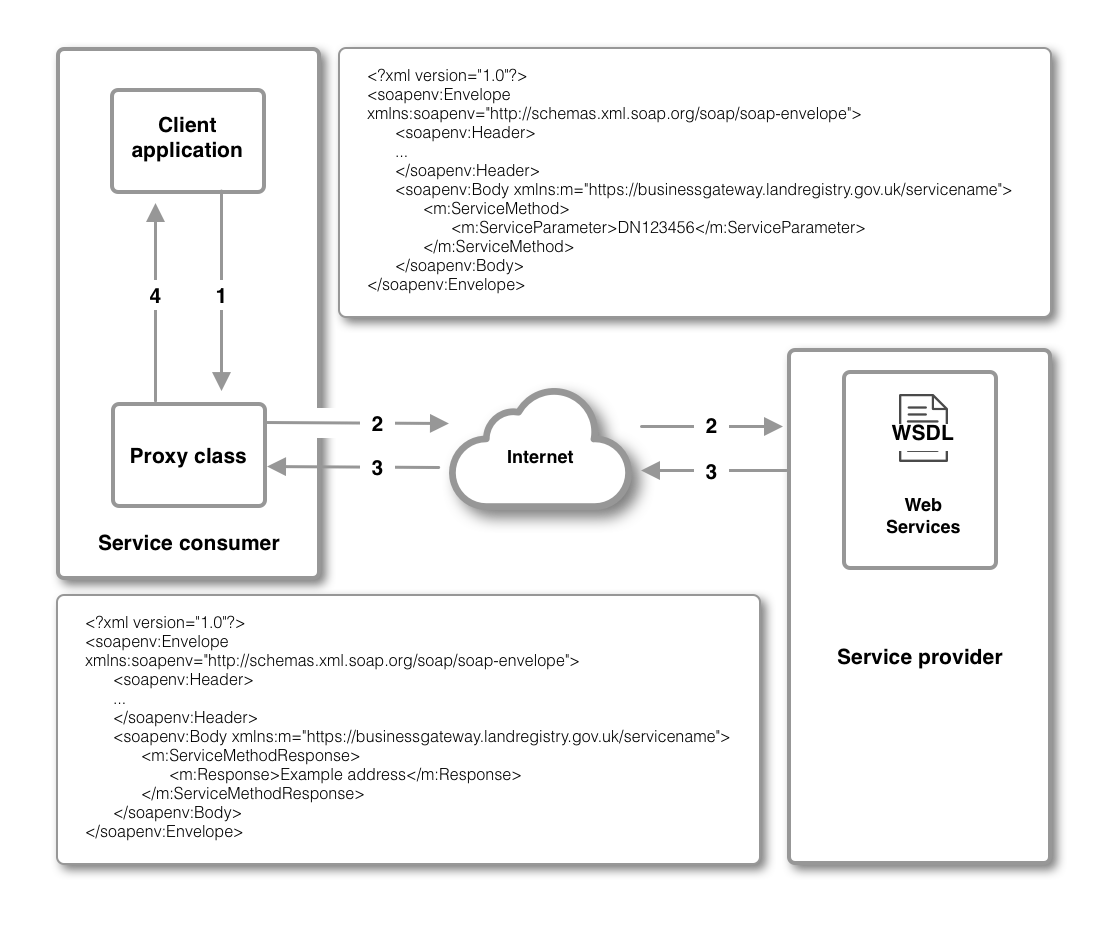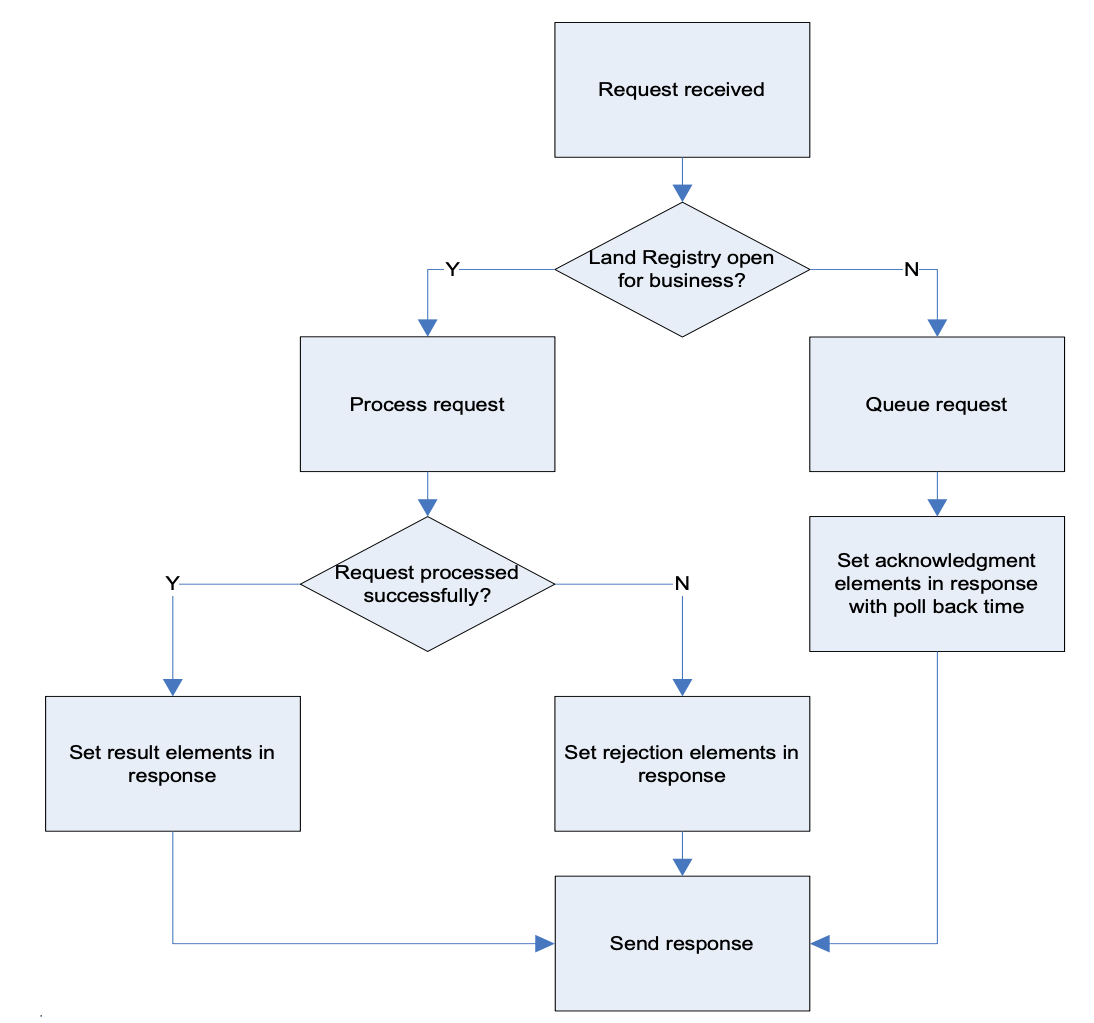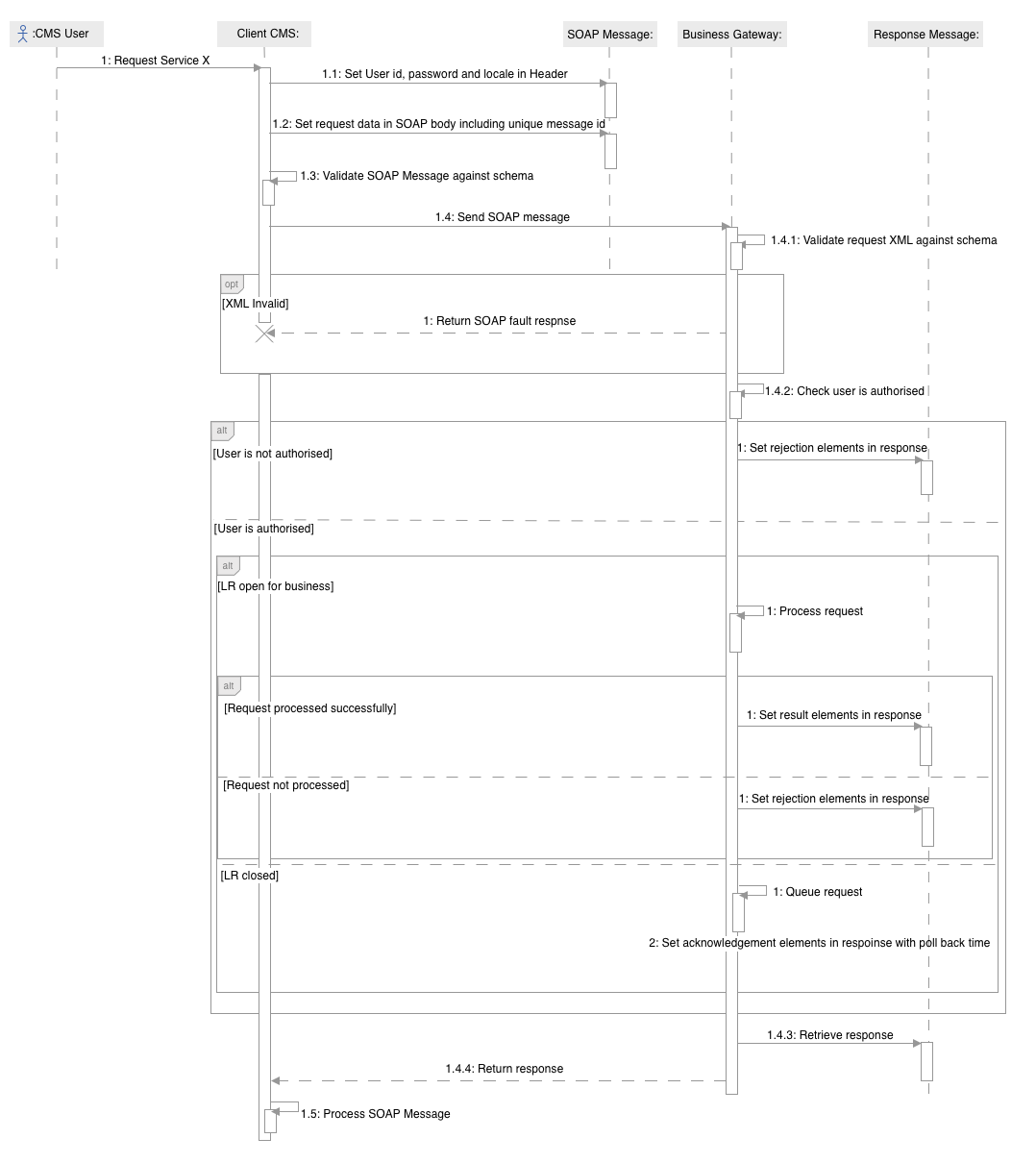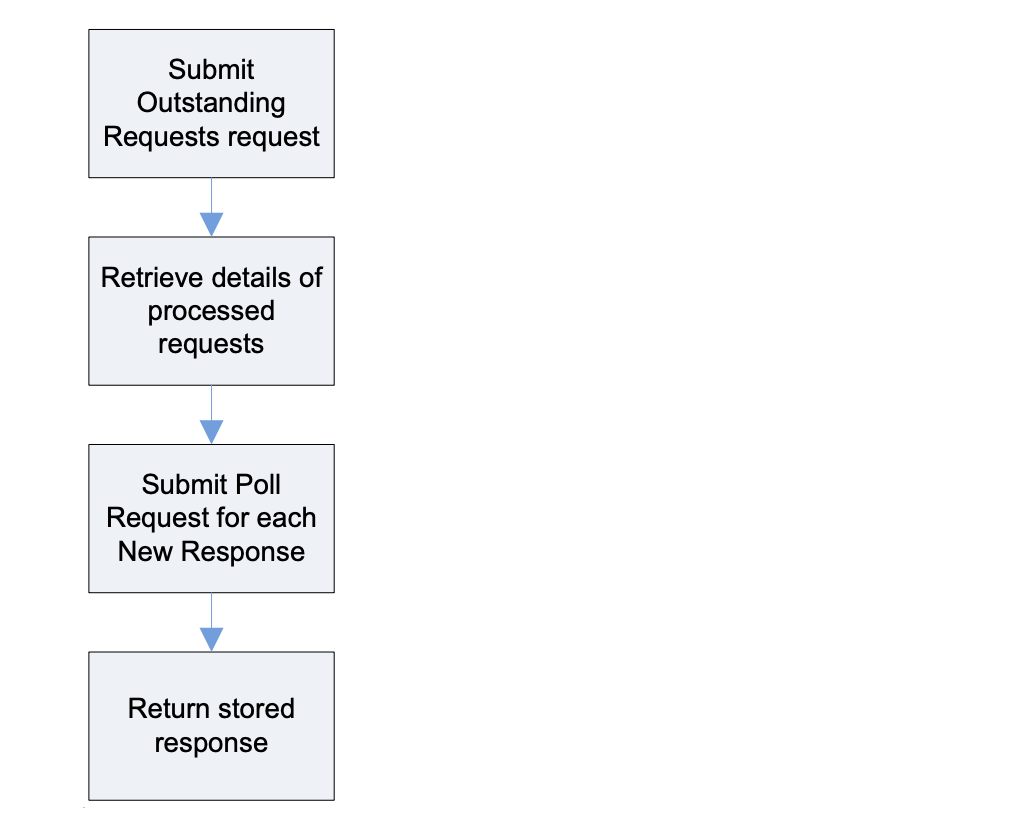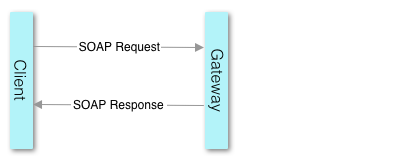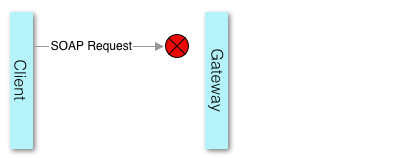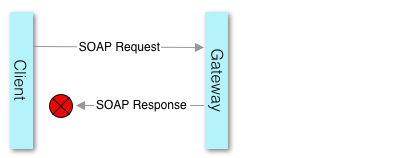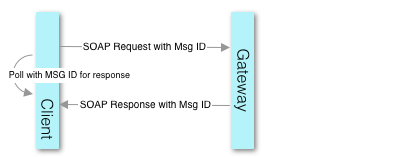How our System Works
Glossary
Overview
Use this document as a guide on how to integrate with our Business Gateway services.
Business gateway
The key features of Business Gateway are:
- adoption of open standards including e-GIF, HTTP, SOAP, WSDL, XML
- XML-based web services
- XML schemas that comply with the standards set by W3C, e-GIF and OSCRE provision of secure access to specific HM Land Registry services over the internet mutual SSL authentication between Business Gateway and client using certificate based authentication
- requests will be queued by Business Gateway when HM Land Registry systems are unable to process requests due to working hour limitations
- synchronous responses to requests when HM Land Registry systems are available reliable messaging facilitated by the use of a unique message ID
- multi-language enabled and facilitated via locale parameters passed in the SOAP header
Architecture overview
Business Gateway
Business Gateway is presented as a collection of web services. An example integration between a service consumer and a service provider is shown in figure 2. The example uses a generated proxy class to allow the client application to consume a web service as if it were a call to a native method. The proxy is generated from the web services described by the WSDL endpoint.
Process flow
- The client application calls the proxy method for the desired web service.
- The proxy class serialises the parameters into a SOAP message and sends it over HTTP to the SOAP endpoint as defined in the WSDL.
- The web services engine de-serialises the received message into an object that is used by the service provider application in a method call. The result of the method call is then serialised into a SOAP message by the web services engine and returned to the service consumer.
- The proxy class de-serialises the response message and returns the web service call result to the client application in a format that is suitable for native consumption.
Example request/response flow
Business Gateway is implemented as a set of web services. It is designed to be highly available and is exposed as a set of pull-for-data interactions. The gateway does not push data to client systems, as this would require client systems to be highly available.
The gateway operates using the following model:
request received in Land Registry business hours, processed automatically – result and response returned synchronously
request received in Land Registry business hours, requires manual processing – acknowledgement response returned
request received out of Land Registry business hours – acknowledgement response returned with a suggested time for poll back
polling request received – response returned if available. If response is not yet available then initial acknowledgment returned.
Using this model, each service offered by the gateway will have a corresponding service to allow for a poll request. A response will consist of an acknowledgment, a result, or a rejection.
For each request the following is required:
- client certificate - provided by Land Registry to create an SSL connection user ID and password to authenticate the user
- locale for the response language - currently only ‘en’ supported
- unique message ID - generated by the client to allow for reliable messaging
Figure 4 shows an example service request. The scenario covers the case where a secure SSL connection has already been created and a service request is being sent for the first time.
The scenario covers the following generic cases:
- SOAP fault due to XML request message failing validation
- rejection response due to authorisation failure
- result response as request processed successfully
- acknowledgement response as request unable to be processed currently
- rejection response as request failed processing
Poll requests
When a request has received an acknowledgment response, the client is required to poll the gateway for a response. This can be automated by the client using the Outstanding Request Service. Figure 5 shows the basic flow for Business Gateway behaviour upon receiving a poll request.
The following scenario demonstrates the polling flow for polling
- A request requiring Land Registry processing is received out-of-hours, or is sent for manual processing
- The request is stored by the gateway.
- A response is sent back to the client with the unique message ID that the client has provided and relevant details (If the request was submitted out of hours, then the response has a predicted processing time. If the request goes for Manual Processing, then the response will contain the ABR).
- The gateway has a scheduler that will run during working hours. The scheduler will fetch pending requests, re-authenticate the user, and then process the request. After the request is processed the response is stored in the gateway for retrieval.
- The client sends an Outstanding Requests request. The gateway returns details of applications with a new response.
- The client submits poll requests for each message returned by the Outstanding Request service.
- The gateway verifies that the user ID of the current request belongs to the same organisation of the original request. The gateway sends the processed response stored in the gateway.
- If a poll request is made for an application that does not have a new response yet, the gateway will return the previous response/acknowledgement.
Security
The solution enforces two levels of authentication. The first level of authentication will be established using digital certificates and the second level will be using user ID and password. Authorisation is via user ID and password. Transport level encryption will be applied over a HTTPS connection.
Interoperability
All web services exposed via the gateway are WS-I and Basic profile 1.1 compliant. Web services invocations using SOAP document literal style will be supported. Any CMS client using a programming language that supports web services such as Java, .net or C++ should be able to consume the WSDL files exposed by the gateway.
Reliable messaging
Web services requests over HTTP/HTTPS internet protocols are not truly reliable and are known for losing messages between request and response. A reliable messaging technique is implemented, to ensure messages are not lost between the client software and the gateway.
Figure demonstrates a normal style of interaction between a client and the gateway where messaging is assumed to be reliable.
Figure 7 shows the scenario where a message is sent to the gateway but is lost in transit.
Figure 8 shows the final scenario where a message is received by the gateway but the response fails to reach the client.
Use of unique message IDs
To facilitate reliable messaging, Business Gateway relies on the client producing a unique message ID that is sent with every request. The message ID is used to retrieve a response back from Business Gateway in the case where the original response has been lost (possibly due to network problems).
The unique combination of message ID, user ID and message type will be used by Business Gateway software internally to ensure that every request is unique in the system. If two requests are made with the same message ID from different CMS systems, although the message ID is the same the user ID will be different. This forms a unique key and the message is therefore uniquely identified in the system.
Message is lost in transit from the client
The client code sends a SOAP request containing a unique message ID and should wait for a response. If the client does not receive a response within a reasonable period, it should send the request again with the same message ID. The client code can continue this pattern until it receives a response from the gateway.
The client code must ensure that all message requests have a unique message ID.
It will be the responsibility of the gateway to correlate the SOAP request and response with the same message ID.
Message is lost in transit from the gateway
The gateway will process the request for the first time and store the response. If a subsequent request is received with the same message and user ID, due to a message being lost in transit between the gateway and the client, then the response will be re- sent using the data stored in the gateway. This will ensure that the initial request will be processed only once.
Resubmission of a failed request
If a response contains a rejection or a SOAP fault then the client code should be able to handle the error condition, make necessary corrections and resubmit the request with a new messaging ID. Message IDs should not be re-used for resubmission. A SOAP fault will only be returned as a result of a system exception, for example a schema validation failure. Any rejections that come from the gateway in terms of a business rule validation failure will be sent as a response containing a rejection reason.
